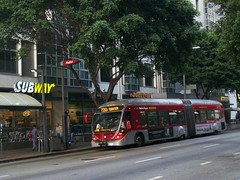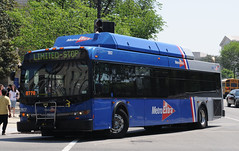Bus rapid transit service vs. express bus service
At the City Council hearing yesterday on streetcars, David Alpert of Greater Greater Washington provided a Powerpoint presentation showing the route of the proposed first phase Anacostia streetcar line. One of the questions Councilmember Graham asked was, for that particular service, would Bus Rapid Transit work better in that particular application.
(I will have a much longer blog post today about the hearing, specifically in response to Councilmember Catania's legitimate points about why Ward 7 and Ward 8 deserve to have first in the city, enhanced fixed rail street-based transit, which I wasn't able to respond to in the hearing.)
Now for the most part, BRT is a "scam" in that (1) the Federal Transit Administration promotes it over fixed rail service because it's cheaper, (2) using the successful experiences in South America as examples; (3) without really disclosing that in South America and Asia, bus riders tolerate passenger densities about double what is typical in the United States. In short, the 60 foot articulated bus used on Georgia Ave. (70s line) or H Street (X buses) holds up to 160 passengers in a place like Curitiba or Santiago, but in the U.S., people feel as if the bus is cramped holding 80 passengers.
It's true that bus rapid transit in Los Angeles has much higher ridership than the highest routes in DC, but DC has a much much smaller population than even the core of LA--it's hard to make a direct comparison in population because the San Fernando Valley is part of the City of Los Angeles, where in this region, that would be like having Montgomery County as part of DC. So that BRT lines in LA have double the ridership of the highest routes in DC isn't as a great a difference as you would think.

MTA Metro Rapid bus on Wilshire Boulevard in Los Angeles.
What we call "bus rapid transit" in the DC region, what I sometimes call "bus rapider transit" is really limited stop express bus service. For the most part the service provided doesn't meet the definition of BRT. (The only place I've ridden on true BRT is in Pittsburgh, which has dedicated busways--former streetcar right-of-way. And it's fast. But you need many buses to equal one 4 or 6 or 8 string of WMATA subway cars.)
From Transit Cooperative Research Program report #90, Bus Rapid Transit. Volume 1: Case Studies in Bus Rapid Transit:
BRT has been defined more comprehensively as a flexible, rubber-tired form of rapid transit that combines stations, vehicles, services, running ways, and ITS elements into a fully integrated system with a strong image and identity. BRT applications are designed to be appropriate to the market they serve and their physical surroundings, and they can be incrementally implemented in a variety of environments (from rights-of-way totally dedicated to transit to streets and highways where transit is mixed with traffic).
In brief, BRT is a fully integrated system of facilities, services, and amenities that are designed to improve the speed, reliability, and identity of bus transit. In many respects, it is rubber-tired LRT, but with greater operating flexibility and potentially lower capital and operating costs. Often, a relatively small investment in dedicated guideways can provide rapid transit. This definition has the following implications:
• Where BRT vehicles (buses) operate totally on exclusive or protected rights-of-way (surface, elevated, and/or tunnel) with on-line stops, the level of service provided is similar to that of heavy rail rapid transit (metros).
• Where buses operate in combinations of exclusive rights-of-way, median reservations, bus lanes, and street running with on-line stops, the level of service provided is similar to that of LRT.
• Where BRT operates almost entirely on exclusive bus or HOV lanes on highways (freeways and expressways) to and from transit centers with significant parking and where it offers frequent peak service focused on a traditional CBD, it provides a level of service very similar to that of commuter rail.
• Where buses operate mainly on city streets with little or no special signal priority or dedicated lanes, the level of service provided is similar to that of an upgraded limited-stop bus or tram system.

Metro Extra limited stop express bus on the Georgia Avenue (70s) line.
(DC articulated bus photo from Flickr by So Cal Metro.)
Labels: bus rapid transit, fixed rail transit service, transportation planning




0 Comments:
Post a Comment
<< Home